Foreclosures Leave Apartment Buildings in Need of Repair
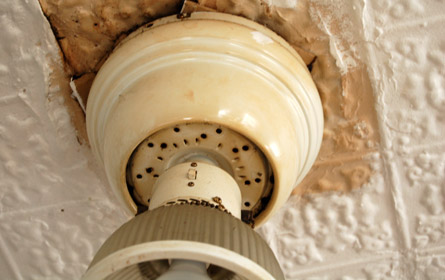
The housing bubble may have burst a few years ago, but many New Yorkers -- and the buildings they live in -- can still feel the pain. An estimated 30,000 foreclosures are pending in courts in the five boroughs, with many cases lingering for years as owners and lenders abandon the properties and leave renters to cope with woeful and often dangerous conditions.
While much of the attention during the crisis has focused on owners of single-family dwellings who cannot meet their mortgage payments and end up losing their homes, thousands of renters whose landlords default also have their homes at risk. Recent litigation and a push for new legislation have combined to shine a light on this situation, but changes are not coming soon enough for residents whose homes are literally falling apart.
"It's a widespread problem in the city," said City Councilmember Brad Lander, who introduced legislation to tackle the issue last spring. "With foreclosures, you wind up with this long limbo period where the owner basically just stops taking care of the building. There are quite a few buildings where tenants have had to live without things like heat and hot water as a result."
Looking for Relief
Many of those tenants have turned to the courts to try to force banks to take responsibility for the properties on which they foreclose. Last month, residents of a 20-apartment building on Longfellow Avenue in the Bronx that is currently in the midst of foreclosure proceedings filed a motion seeking to compel New York Community Bank to put up the money necessary to carry out much needed repairs. The building fell into disrepair shortly after it was purchased in 2007 by a company identified as 1255 Longfellow LLC with a $1.1 million loan. Since then the city has issued the building 117 housing code violations including sporadic heat and hot water during winter months, widespread mold and caving ceilings.
In May, six elderly and or disabled tenants of a small rent-regulated apartment building in Brooklyn that is currently in foreclosure proceedings filed a similar motion. They claim that they have been forced to lived with deteriorating conditions, including intermittent heat and hot water, a leaking roof in danger of collapse and an unsecured front door, since the building's owner defaulted on a $1.85 million mortgage more than two years ago.
As in the Bronx, these tenants want the court to force the bank to put up the money necessary to make the building habitable. Both cases are bolstered by the precedent set last year when the Bronx Supreme Court ordered a bank in a foreclosure action to advance $2.5 million for the purposes of making repairs at 10 overleveraged and dilapidated apartment buildings.
The Brooklyn building sits smack dab in the heart of Fifth Avenue -– Park Slope's bustling main thoroughfare -– across the street from a hip Thai restaurant and around the corner from a new, white table-clothed steakhouse. Inside, it is worlds away from the brownstones, boutique shops and organic coffee houses that helped earn Park Slope the New York Magazine's "Most Livable Neighborhood in New York" titlelast year.
According to the Department of Housing Preservation and Development, the property currently has 109 outstanding housing code violations (up from 91 at the time the tenants filed their motion), ranging from inadequate lighting near the front entryway and crumbling plaster to mold, exposed electrical wire and mice infestation. That's not to mention the broken lights and windows as well as cracked floor tiles in individual apartments. In July, the former owner -- 294 5th Ave. Associates LLC -- was ranked second on Public Advocate Bill deBlasio's list of the city's worst landlords.
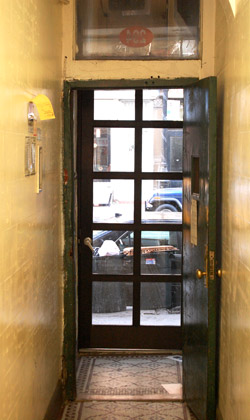
More than four months have passed since the motion was filed and the building's front door remains unsecured, the locks on both the front and interior door broken. "That's always been a problem. They fix it and then all of a sudden it's damaged again," said Raymond Jimenez, a retired butcher who has lived in his fourth floor apartment for 48 years. Although a court-appointed receiver recently hired workers to resurface the building's roof, leaks continue.
Recipe for Disaster
The scenario leading up to such cases generally went as follows: A landlord obtained a mortgage and purchased an apartment building during the booming 1990s or early 2000s, often for more than the property was worth. In the Park Slope case, "the owner got a mortgage for $1.85 million. The most that the property could have supported was probably about $500,000," says Brent Meltzer, an attorney for South Brooklyn Legal Services who represents the tenants.
By 2008 or so, the housing market began to dive, and the property was no longer worth as much as the owner paid for it. Operating costs such as water and insurance also increased dramatically, making it difficult for landlords to cover their costs. In rent regulated buildings, the owners were limited in how much they could raise rent, and even in buildings that were not regulated, the market kept landlords from increasing rents. This left the landlords to choose between using rent proceeds to meet mortgage payments or for the building's maintenance and repair. The former inevitably won out, but many owners still could not pay the mortgage, and so the lending bank eventually foreclosed on the property.
A bank that forecloses on a property does not officially become the property owner -- with both the right and responsibility to enter the building and perform necessary maintenance and repairs -- until the legal process is completed. During the intervening months or years, the property and its tenant remains in a no man's land of sorts, according to Lander, whose district stretches from the Columbia Waterfront to Borough Park and includes Park Slope. "The bank brings the foreclosure, the owner essentially walks away and there's no one left to take care of the building," he said.
The court typically appoints a receiver to collect rent and use the money to perform limited maintenance, but not necessarily to make significant physical improvements. "The receiver is not there to fix up the building and make it better. Its role is basically to do general upkeep," Meltzer said.
In the Brooklyn case, the court didn't appoint a receiver until almost a year after the foreclosure suit began. A court order limits him from spending more than $2,000 on a single repair without the bank's consent.
Physical problems often occur in these rent regulated apartment buildings facing foreclosure both because the buildings are typically older and require substantial maintenance and because the relatively low rent income made it difficult for landlords to make major repairs.
Money for Maintenance
The foreclosure process, said Meltzer, is messy. "Everyone is trying to point the finger at someone else. Meanwhile, the tenants are just sort of stuck sitting there without repairs being done," he said.
In an effort to change that City Council is considering three bills. Intro 494, proposed by Lander, would require a bank seeking foreclosure to post a bond to cover the cost of any emergency repairs along with fees and fines for housing code violations. Housing committee chair Erik Dilan has two measures: Intro 500, which would make a bank seeking to foreclose on an apartment building responsible for maintaining the property, and Intro 501, which would require a bank bringing a foreclosure action to register with the city housing department within 10 days after it initiate the action.
The measures' supporters and tenants’ attorneys reason that banks should be responsible for the conditions at foreclosure properties because they helped create those conditions by providing "overleveraged" loans, mortgages with a monthly payment that cannot possibly be covered by rental income.
"The problem over the past five years has been the banks bankrolling this," Ian Davie, a Legal Services attorney representing the Bronx tenants, said. "It's very straight forward: The income from the building can't support the debt service on the mortgage."
New York Community Bank, the city’s largest multifamily lender, is also one of the largest overleveraged loan bankrollers, according to Davie. In June, city Housing Commissioner Matthew M. Wambua wrote a letter to the bank, imploring it to take action to improve the conditions at a number of distressed properties in the bank's portfolio. Noting that the bank's "holdings are some of the most distressed properties in New York," said the buildings cost the city money by lowering nearby property values (and tax revenue) and requiring increased police, fire and sanitation services. Wambusa went on to warn the bank, "It cannot be the responsibility of the City of New York to subsidize irresponsible property owners."
But not everyone agrees that a foreclosing bank should be responsible for building upkeep and maintenance. "If enacted, the legislation will discourage financial institutions from extending mortgages in the city, as they will then face monetary obligations that have become completely unpredictable and wholly disproportionate to their mortgage investment,” says Christopher H. Palmer of Cullen and Dykman, LLP, the law firm representing New York Community Bank in the Bronx litigation.
In an April hearing on the bills deputy housing Commissioner Ruthanne Visnauskas questioned the legality of requiring a bank that doesn’t technically own a building to enter it and make repairs. Visnauskas also expressed concern that "the obligations imposed by 494 and 500 may discourage lenders from providing mortgages" and "imposing financial requirements may deter lenders from foreclosing altogether."
Palmer says that lawmakers should instead focus on speeding up foreclosure proceedings and requiring that a receiver be appointed immediately after the proceedings are initiated. "We need to expedite and streamline the New York foreclosure process if we are going to return these distressed properties back to responsible ownership and better management," he said.
Perhaps the one thing that everyone agrees on is that the foreclosure process leaves tenants in a precarious situation.
Jimenez pays $152 a month for his apartment. While renters paying 10 times as much or more for their apartments may have a hard time empathizing with him, Meltzer said there are a host of reasons why they should be concerned about him and his neighbors. "No matter how much they're paying, no one should be living without heat or hot water, especially elderly and disabled tenants and especially in New York City," Meltzer said.
The Park Slope tenants, he said, have earned their homes. "Don’t forget, this was a different neighborhood 10 years ago. This wasn’t Park Slope, this was Gowanus. These are the people who stabilized the neighborhood when New York was falling apart. They lived there in the '70s and '80s when people who are living there now wouldn't dare to," he said.
So Meltzer, Lander, Davie and others plan to continue working on behalf of these and similar tenants. "This is a problem that's not going to go away anytime soon," Davie said. "We will certainly keep trying to fight to hold banks accountable."
9/11: 10 Years of Reporting
From the morning that the planes struck the World Trade Center on Sept. 11, 2001, Gotham Gazette has been covering the efforts of New Yorkers to cope with the unthinkable, to rebuild their city and to adjust to a new, often frightening time. For three years, Gotham Gazette provided intensive coverage of the efforts to recover and then rebound in Rebuilding NYC, and though less intensive, our reporting on the myriad of issues raised by the attacks has continued.
Below we offer some selections from our 10 years of coverage – from Sept, 11, 2001 through today. We apologize for any formatting glitches in the older stories.
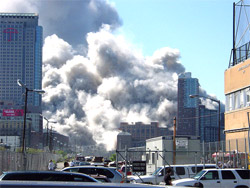
Twin Towers Account: An account from lower Manhattan of the first few awful hours after the attack. (Sept. 11, 2001)
Immigrants Under Attack: Sept. 11 have had a sharp impact on many Americans. But for immigrants and members of some minority groups, including Arab Americans and Muslims, the effects have been particularly dire. (Oct. 1, 2001).
Everybody Loves New York -- For Now: Almost as soon as the hijacked airliners hit the Twin Towers, Americans began reaching out to New York, feeling shock and horror, expressing support, trying somehow to help. The city that much of America once loved to hate was now the subject of sympathy, admiration and even affection. (Oct. 15, 2001)
Not Always as Sweet: Debbie Almontaser, an activist and educator, writes of life as a Muslim in New York before and after 9/11. (Fall 2001)
Living Near Ground Zero: Many of the people who live in Tribeca, the financial district and tucked into lofts hidden above store fronts around City Hall soon returned to their homes. Three months after they fled from the unimaginable, they have returned to live with the inescapable. (December 2001)
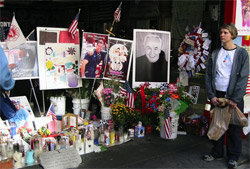
The Fire Department: The terrorist attacks had perhaps their most devastating impact on the fire department. The police department lost 23 and the Port Authority lost 37 uniformed officers. But 343 firefighters died. (Dec. 3, 2001)
The 'New" New York Skyline: Architecture critic Paul Goldberger discusses what New Yorkers feel and face as they struggle to make their city whole. (Jan. 25, 2002)
Art and Artists After September 11: Jon Stewart moderates a discussion with Karin Batten, Spalding Gray, Susan Sarandon and Wendy Wassertsein. (May 2002)
Rebuilding by Consensus: Nine months after the attacks, New Yorkers imagined what they wanted to see in lower Manhattan. (June 10, 2002)

A Conversation with Daniel Libeskind: The architect, whose design was then a finalist for the trade center site, discuses his plan and the ideas behind it. (Feb. 20, 2003)
Virtual Tour of the Chosen Design: An in-depth look at Daniel Libeskind's original design for the World Trade Center site. (March 2003)
A Year with Libeskind: The winning design for the trade center site evolves. (March 1, 2004)
Mapping Ground Zero: Dozens of ways of looking at lower Manhattan, past, present and future.
9/11 and Inappropriate Art: Harsh words and controversies flare over what can be displayed near Ground Zero. (Sept. 9, 2005)
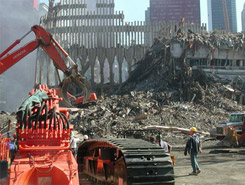
The Heroes of 9/11 Are Getting Sick: Working at Ground Zero seems to have been even more dangerous than initially suspected, say health researchers as rescue workers die from illnesses that seem to be related to working on "the pile." But James Zadroga's death in particular has redirected attention to a problem that, experts say, will likely continue for decades. (Jan. 30, 2006)
The Price of Increased Surveillance: Eighty-two police cameras didn't thwart the 2010 Times Square bomb attempt. But in response, the mayor called for more cameras. Will technology keep us safe? Take away rights? Or both?

9/11 Memorial Nears Completion: On the 10-year anniversary of the Sept. 11, 2001 attacks, the National September 11th Memorial will open to the public, marking the end of a complex, drawn-out and sometimes chaotic process. (July 14, 2011)
Letting History Speak for Itself: An interview with memorial designer Michael Arad. (July 15, 2011)
Improving the Zadroga Act: Those who rushed to the World Trade Center site right after the 9/11 attacks hope a new report will boost their demands to aid fellow responders who now suffer from cancer. (Sept. 6, 2011)
Progress on Fulton Street: After delays and cost overruns that threatened to all but destroy the project, parts of the Lower Manhattan transit hub have started to open. (Sept. 7, 2011)
Tallying the Losses: Some sense of the almost incalculable impact of 9/11 can be gained from then numbers. Andrew Beveridge offers a statistical portrait of our losses – personal and economic. (Sept. 8, 2011)
Mayor Still Looks to Building and Zoning to Ease Housing Crunch
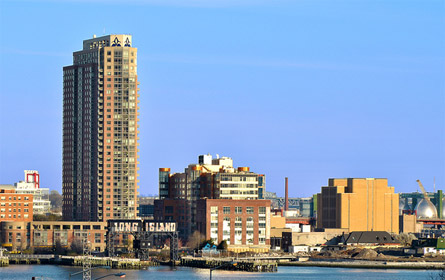
Albany last month finally found a way to continue rent regulations in the city. But the new regulations barely address the bigger issues facing housing in the city -- long-term affordability for most tenants and homeowners.
The city's long-term sustainability plan, PlaNYC2030, does acknowledge that challenge. And in its update released earlier this year, the Bloomberg administration takes these efforts a bit further, acknowledging the importance of saving housing and the neighborhoods where people live. However, that too falls short because the mayor still puts the priority on zoning to promote new housing and gives short shrift to preserving our neighborhoods.
After the Bubble
On the bright side, New York City is doing better overall than many other cities, according to a recent report by NYU's Furman Center, though comparisons can prove difficult because New York's housing, with so many large rental buildings, differs from that of most other cities. Recent announcements of some major new luxury apartment and office deals seem to suggest New York is a long way from any catastrophic collapse.

Despite these hopeful signs, a raft of problems still afflicts housing in New York. Three years after the housing bubble burst, hundreds of construction sites around the city remain stalled. Developers face a shortage of cash, and banks are reluctant to finance purchases. Also, cuts to federal rent subsidies are hurting both tenants and building owners. Public housing is broke, and the city housing authority is looking for private partners to bail it out. Other staples of affordable housing in New York, such as the Mitchell-Lama program, have dwindled after decades of private sellouts.
In a flat economy with high unemployment, tenants and some homeowners in the city face big tax bites. Many homeowners grapple with mortgage debt, while housing values remain stagnant. There are some 40,000 homeless peopleliving in shelters, over 9,000 households currently affected by foreclosures, about 700 buildings vacated by city order and a record-high stock of what experts euphemistically call "distressed housing" -- homes that are poorly maintained, over-mortgaged and in deep trouble.. And the Rent Stabilization Association reports that last year over 13,000 apartments were decontrolled and thus less likely to remain affordable.
According to the Real Deal, "Home prices declined between the last quarter of 2010 and the first of 2011 in every borough except Queens where housing prices were flat but remain about one third lower than peak values in the fourth quarter of 2006 and mid-2007." And the Wall Street Journal reported that many condos and homes in the city have borrowed more than the current value of the property.
As both housing advocates and real estate investors are quick to point out, housing is not just about a roof over your head, it is about having a home in a decent living environment, or "location, location, location" to use the real estate industry phrase. And affordable neighborhoods are in trouble.
During the real estate bubble, many tenants and homeowners in affordable apartments and homes that were subsidized with public money either took cash incentives to move or were pushed out of their homes. This fractured their connections to friends and neighborhood, a prime element in the city's lively communities. A mix of long-time residents was replaced by a homogeny of young singles seeking the "authentic" neighborhoods that are no more. The remaining affordable neighborhoods are looking at the possibility of more overcrowding, less money for building maintenance and more vacant buildings.
Gaps in the Plan
Looking at the city's long-term housing plan, you would never know there had been a bubble or that we cannot simply build our way out of any crisis. The PlaNYC2030 four-year update, released on Earth Day this year, is all about building hope and enabling new apartment construction. With its penchant for numerical targets, the plan focuses on how many homes the city plans to create and preserve by stimulating growth through zoning changes.
One of the plan's goals is to have completed 165,000 affordable units by 2014. Almost two thirds of these will be renovations of existing units, and only one third will be the result of new construction. All accounts suggest that numerical goal will be met, though it's not clear what is expected to happen after that – almost certainly under the next mayor, who may very well ignore this administration’s plan altogether.
As commendable as the accomplishments may be, meeting the 2014 target will not solve the city's more deep-rooted affordable housing problems. The city’s housing plan is all about increasing supply, mostly by encouraging market-rate development, yet the real crisis has been the loss of existing affordable units. If the past is prelude to the future then the city may end up losing more affordable housing than it is able to create. The mayor has on many occasions claimed that attracting more people with higher incomes is a sign of a successful city, yet more upscale housing is likely to increase rents and house values in existing affordable neighborhoods.
The emphasis on encouraging new construction flows from the prediction that almost a million more people will live in New York by 2030. The 2010 census refuted the city's optimistic population projection -- although the city charges that the census undercounted in many neighborhoods. However, the jury is still out, and the optimistic estimate of growth looks more like a goal to be attained than a challenge to be met. (See my 2007 analysis, which cited PlaNYC2030's departure from standard projection methods).
To house these additional New Yorkers, the administration hopes to build more housing near transit stops and on cleaned-up industrial land. It claims that this "transit-oriented development" (defined in the plan as projects within a half mile of mass transit, which covers 70 percent of the city) and "brownfields reclamation" (cleaning up and building on abandoned industrial sites) will help achieve the mayor’s goal of a "greener, greater New York."
However, Brian Paul and Melissa Checker, both writing in Gotham Gazette, have questioned how effective these strategies will be. As evidence of what they hope to accomplish, the city's planners point to large-scale projects for new development such as Hunters Point and Willets Point in Queens. It is a bit of stretch to call either of them transit-oriented when they are expected to include substantial parking and will have to rely on the declining fortunes of bus transit in the outer boroughs.
Then there is the issue of who will be able to afford to live there. Some projects , including Hunters Point, define affordable by using the official area median income, which is almost twice as high as the median in New York City. Thus, most people with low incomes will not be able to afford these homes. Another large project slated for affordable housing, Forest City Ratner's Atlantic Yards in Brooklyn, has yielded only a basketball arena after some eight years of planning.
The most telling map in the 2030 plan update housing section shows the concentration of "affordable" homes created under the mayor's New Housing Marketplace plan since 2004. They are concentrated in the neighborhoods in central Brooklyn and upper Manhattan that have experienced intense gentrification and where many more affordable units have been lost. The map only shows the number of new units added, not those that have been lost, ignoring the fact that some of these neighborhoods now have fewer moderately priced homes than they did in 2004.
The new version of the 2030 plan does acknowledge the significant erosion of affordability guarantees (like those provided by the Mitchell-Lama program), and at one point proposes extension of these guarantees. It remains to be seen whether efforts to do this will gain any traction in years to come.
A Nod to Neighborhoods
One of the admirable changes to the mayor's long-term plan is that the housing section is now called Housing and Neighborhoods. Missing in the earlier version was any idea that housing is only one aspect of the quality of life in the hundreds of diverse city neighborhoods.
As welcome as this change may be, when you dig into the plan's content, it's hard to find any major role for neighborhoods. The mayor remains focused on bringing in new housing -- not on a set of neighborhood plans for improving housing, or a plan in which both City Hall and communities participate. There is no clear role for community-based organizations, civic groups or community boards. The city’s 59 community boards, though poorly funded and lacking official power, are the only official institutions at the neighborhood level.
Although the 2030 update proposes a Greener Greater Communities initiative and mentions a particular example involving community groups in East New York, this focuses on energy conservation, open space and other environmental improvements without necessarily addressing the big question of affordability in a neighborhood that has very high levels of foreclosures. The plan's contribution to community involvement is summed up in the proposal to create a web site, Change By Us, that would encourage people to organize to solve problems by providing them with information. To the thousands of dedicated housing activists around the city who are already organizing and whose real problem is not information but more support from public agencies, this could sound a bit patronizing. Perhaps what is needed is a better way advocates for affordable housing can help shape city housing policy so that it truly strengthens neighborhoods.
In the 2030 plan update, zoning remains the main tool for promoting new housing development as it has been in the last decade. The City Planning Department boasts of having completed a record 100 rezoning plans in that time period.
The plan does not address, even briefly, concerns that zoning changes may have contributed to the wave of gentrification and displacement or fueled the real estate frenzy, as strongly hinted in another report by NYU's Furman Center. That study showed how zoning changes protected many white, middle class neighborhoods by reducing options for new development, while concentrating growth in lower-income communities of color, the very neighborhoods where large numbers of people are being priced out of their apartments. The city's inclusionary zoning policy, which gives developers bonuses for building affordable housing, has produced less than 2,000 units over the last decade while more than 200,000 affordable units were lost.
Of the 11 initiatives listed in the Housing and Neighborhoods section of the updated PlaNYC2030, the last two are the most important because they focus on preservation and not new development. The first, initiative 10, sets a goal to "preserve and upgrade existing housing," and identifies new and beefed-up programs to finance building rehabilitation; it proposes strengthening existing affordability guarantees so that they last longer. Also, the Small Owner Repair Program and other initiatives would help preserve 34,000 housing units through 2014.
Initiative 11 is potentially the more path-breaking because it aims to "proactively protect the quality of neighborhoods and housing." The plan commits the city to the important task of identifying distressed properties. Its goal is to evaluate 1,000 at-risk buildings in three years, most likely only a fraction of the total.
The two short paragraphs dedicated to this item provide little sense of where this is going. Overall, these two initiatives could represent a welcome change in focus by the Bloomberg administration. It remains to be seen, however, whether they are an afterthought or a genuine move to strike out in a new direction, away from a focus on new development and toward greater emphasis on preservation.
Tom Angotti is director of the Hunter College Center for Community Planning & Development and co-editor of Progressive Planning Magazine.




